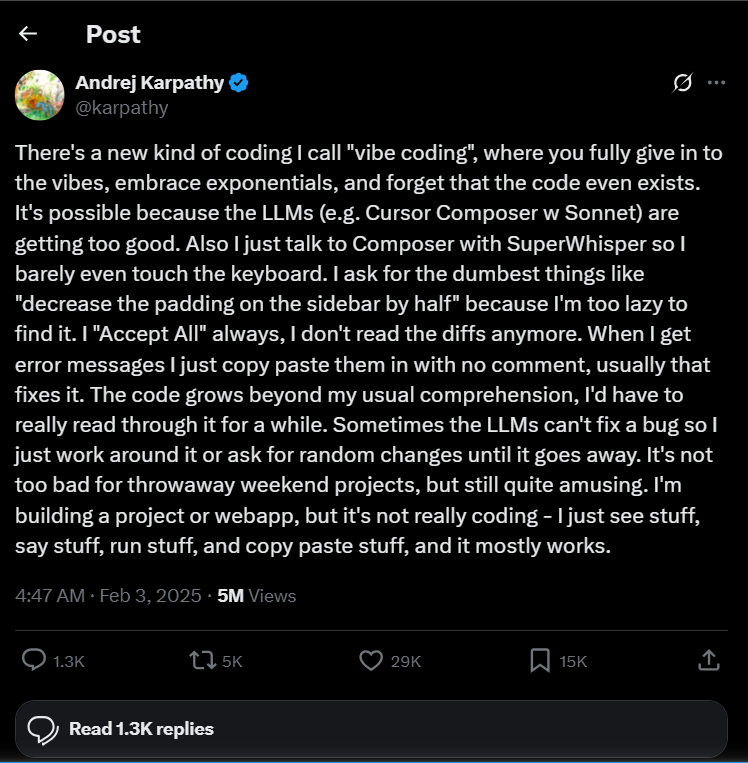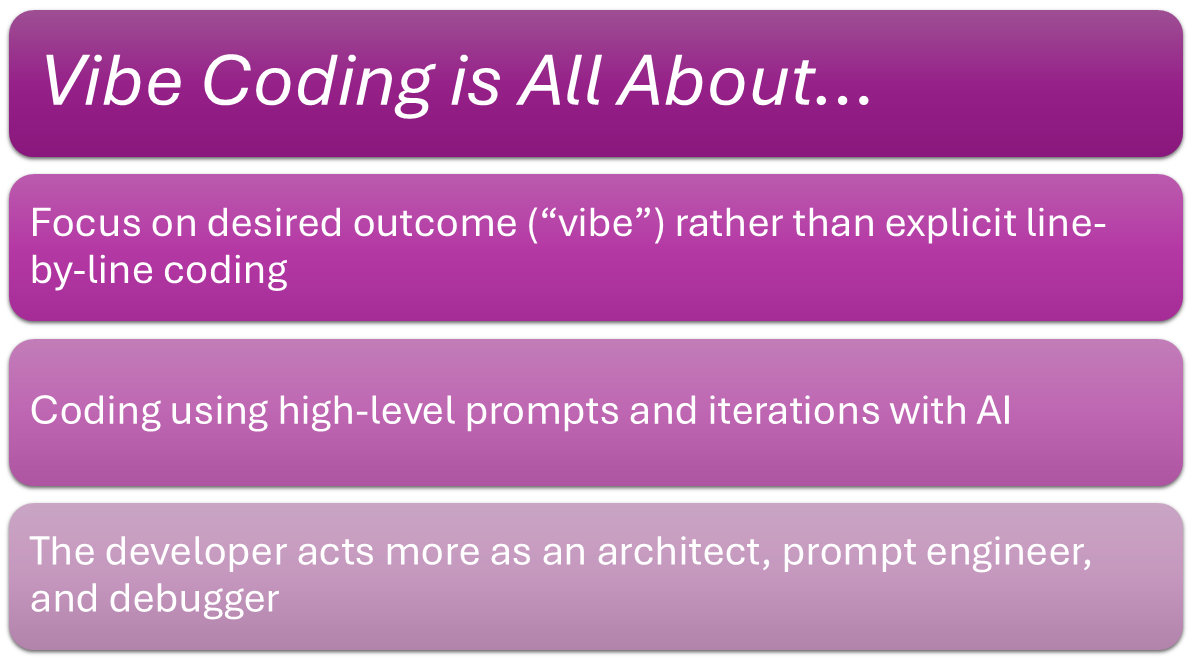What is Vibe Coding?
|
|
“It’s all about the vibes” … holds true these days even in the world of software!
You can do a lot more with Artificial Intelligence (AI) besides asking general knowledge questions. AI can write code for you. Vibe coding is like doing pair programming with AI. If you are one of the many tech-savvy people who are always looking out for what’s new in the tech world, then you must be familiar with this new trend already. Andrej Karpathy (co-founder at OpenAI and former AI leader at Tesla) coined this term on his X account earlier in 2025.

Seems interesting, doesn’t it? Let’s learn more about this interesting approach to coding.
| Key Takeaways: |
|---|
|

What is Vibe Coding?
What if you want to build a simple website, but are not a professional coder? You know what you want it to look like, what buttons it should have, and how it should behave. Traditionally, you’d have to learn a lot of coding languages, syntax rules, and frameworks to translate that vision into actual working code. This is where “vibe coding” comes in.
At its heart, vibe coding is about building software by focusing on the feel or intention of what you want to create, rather than getting bogged down by lines of code. This is a new way to build applications where your main job is to give high-level, natural language instructions to an AI. You’re no longer focused on writing every line of code, memorizing complex syntax, or figuring out the perfect way to structure a function. Your role shifts to simply describing your intention. The AI then generates the code for you.

Using vibe coding, you can code in two ways:
- Focus only on the vibe. This whole idea was popularized by Andrej Karpathy, who famously said that in this new world, you could “forget that the code even exists“. The process becomes a simple conversation. This works well for prototyping or throwaway projects.
- Pair programming with AI. You prompt the AI with a goal, like “create a contact form for a website”. The AI generates a draft. You then test it and tell the AI what needs to be changed, like “add a field for phone number validation”. This cycle of Prompt → Generate → Test → Refine continues until you have a working, polished result. It’s less about being a manual laborer and more about being a creative problem-solver.
Examples of Vibe Coding
- Quick Prototyping: Imagine a designer wants to quickly show a client how a new layout would work. Instead of building it pixel by pixel, they could “vibe code” the basic structure and interactivity in minutes.
- Hobbyist Creations: Someone with a great idea for a simple app but no coding background could describe their idea, and the AI assistant would generate the foundational code, allowing them to focus on the creative aspects. Read: AI Assistants vs AI Agents: How to Test?
- Generating Boilerplate: For experienced developers, instead of writing repetitive setup code (like connecting to a database or setting up a basic web server), they could just tell the AI, “Set up a Node.js server with Express and a basic ‘hello world’ route,” and the code would appear instantly.
The Vibe Coding Software Process

In a vibe coding scenario, your daily routine as a developer (or even a hobbyist) shifts dramatically:
- Start with the Big Picture: Instead of opening a blank code editor and writing <html> or public static void main, you start by describing your goal in plain language. You might say, “I want a simple web page with a ‘contact us’ form, a header that says ‘My Awesome Project,’ and a button that, when clicked, shows a success message.”
- Prompt Your Intelligent Assistant: This is where the magic happens. You type your description into a special tool – let’s call it your “AI coding assistant”. This assistant isn’t just searching the internet for answers; it’s designed to understand your intent and generate actual code based on that understanding. It’s like talking to a highly skilled, incredibly fast programmer who anticipates your needs. Read: How to Become a Prompt Engineer.
- Review and Refine: The assistant quickly writes some code. Your job isn’t to write, but to review it. Does it look right? Does it do what you envisioned? You might see the code for the web page, the form fields, and the JavaScript for the success message.
- Iterate and Direct the “Vibe”: This is where “vibe” truly comes into play. If the button looks clunky, you might tell the assistant, “Make that button sleek and modern, with a soft blue gradient.” If the success message appears too slowly, you’d say, “Make the success message appear instantly and fade out after two seconds.” You’re giving high-level directions, focusing on the desired experience or vibe, and the assistant handles the intricate code changes. You’re shaping the output by telling it how it feels or behaves.
- AI-Assisted Debugging: Even the smartest assistants can make mistakes, or your initial “vibe” might have been unclear. If something isn’t working, you don’t necessarily hunt for the bug yourself. You might point to the problematic area and ask, “Why isn’t this form submitting?” or “This button isn’t doing what I expect. What’s wrong here?” The AI assistant will then analyze the code it generated and suggest fixes, or even make the corrections directly. Read: Testing vs Debugging.
Vibe Coding Tools and Technologies
At its core, vibe coding relies on several sophisticated technological components, all designed to understand your natural language instructions and translate them into functional software.
Large Language Models (LLMs)
The core technology powering this new way of working is something called a Large Language Model (LLM). You’ve probably heard of these, as they’re what power services like Gemini and ChatGPT. These models are incredibly good at understanding human language and generating text, which, in this case, just happens to be computer code.
Code Generation and Vibe Testing Tools
Building on LLMs are more specialized tools known as AI agents. Think of these as super-smart helpers that live inside your development environment, like your code editor. They don’t just offer suggestions; they can take on entire tasks and manage multiple steps for you.
Here are a few of the most popular tools helping developers embrace vibe coding:
- GitHub Copilot: Often considered the original “AI pair programmer,” Copilot works right inside your code editor, offering real-time suggestions as you type. It’s like having a knowledgeable friend next to you, finishing your sentences with full lines of code.
- Cursor: This is a code editor that was built from the ground up with AI in mind. Instead of just offering suggestions, you can ask Cursor to do things like “add a new feature” or “find and fix a bug” using simple chat prompts.
- Replit: An online platform that lets you code, build, and deploy entire apps in one place. Replit has integrated AI agents that can help you plan and build full-stack projects, from the database to the front-end user interface, just by giving it directions.
- testRigor: Enables vibe testing by allowing QA teams to validate not just functionality, but also the overall user experience and “feel” of the application. With plain English test cases, it helps teams capture workflows as end-users perceive them, ensuring alignment with product intent through Gen AI, NLP, AI context, Vision AI, and advanced AI algorithms.
These tools provide the user interface and the underlying logic to connect your natural language prompts to the LLM, receive the generated code, test it, and present it back to you in a usable format.
Pros and Cons of Vibe Coding Concept
Just like any new technology, vibe coding comes with its own set of advantages and challenges. It’s important to understand both so you can decide when and how to use it effectively.
The Upsides (Pros)
- Rapid Prototyping: This is arguably the biggest advantage. You can go from an idea to a working version of an app in a matter of hours or days, not weeks or months. This is perfect for testing out a new concept or quickly building a small, personal tool.
- Lower Barrier to Entry: Because you’re not focused on memorizing syntax or complex commands, vibe coding makes it much easier for beginners or people with no programming experience to build real, functional software.
- Focus on High-Level Design: When you’re not bogged down in the small details, you can spend more time thinking about the overall design of your application. This allows you to prioritize a good user experience and a solid architecture. Read: High-Level Design (HLD) vs. Low-Level Design (LLD).
The Downsides (Cons)
- Technical Debt: AI-generated code isn’t always clean or well-structured. If you don’t take the time to review and clean it up, you can end up with a codebase that’s difficult to maintain, which is a major problem down the road. Read: How to Manage Technical Debt Effectively?
- Security Risks: The code generated by AI may have hidden security vulnerabilities or a lack of best practices. If you’re a beginner, you might not know how to spot these flaws, which can lead to serious issues in a production environment.
- Debugging Challenges: It’s much harder to fix a bug in a program you didn’t write. If something breaks, you have to spend time figuring out what the AI did and why it’s not working, which can sometimes be more time-consuming than just writing the code yourself.
- Loss of Foundational Knowledge: Over-relying on AI can prevent you from building a deep understanding of core programming concepts. While it’s great for getting started, it can stunt your growth as a developer if you don’t also spend time learning the fundamentals.
Who is Vibe Coding For?
So, who benefits from vibe coding exactly? The surprising answer is: almost everyone. This new approach offers unique advantages depending on where you are in your coding journey.
- For Beginners: If you’re just starting out, vibe coding is a game-changer. It lowers the barrier to entry by removing the initial pressure of learning complex syntax and rules. You can jump straight into building a project. It’s a great way to build confidence and see your ideas come to life quickly.
- For Developers & Startups: If you’re working on your own or with a small team, speed is everything. Vibe coding is perfect for rapid prototyping and validating ideas. You can build a basic app or a new feature in a fraction of the time, allowing you to get feedback from users and iterate much faster than you could with traditional methods.
- For Experienced Developers: Even seasoned pros have a lot to gain. Vibe coding is a powerful tool for automating all the repetitive, tedious parts of coding – the “boilerplate” work. This frees up your time to focus on complex architectural challenges, explore new frameworks, and solve the really interesting, high-level problems that require human creativity.
Vibe Coding vs. Traditional Coding
| Feature | Traditional Coding | Vibe Coding |
|---|---|---|
| Primary Task | Writing and debugging code line-by-line. | Prompting, reviewing, and refining AI-generated code. |
| Required Skills | Deep knowledge of programming language, syntax, algorithms, and data structures. | Strong communication skills (written for prompting AI), understanding of problem-solving, and critical thinking. |
| Main Tool | A text editor or IDE (Integrated Development Environment). | An AI-powered code assistant (e.g., GitHub Copilot, Cursor). |
| Speed | Often slower, as it requires manual effort for every detail. | Significantly faster for creating first drafts and prototypes. |
| Role of Developer | A craftsperson who builds the product. | A director who guides a team (the AI) to build the product. |
| Learning Curve | Generally steep | Much lower |
The Future Looks Bright
As technology advances, we’re likely to see this concept of vibe coding evolve as well. However, in this new era, the role of a developer isn’t going away; it’s just evolving. It’s shifting from that of a manual laborer to a creative problem-solver and strategic thinker, with AI as a collaborator.
The most effective developers in the future will likely use a hybrid workflow. They will utilize AI for speed, using it to handle the repetitive, tedious parts of coding and to rapidly prototype ideas. At the same time, they will maintain the human oversight that is crucial for ensuring the quality, security, and architectural integrity of an application.
| Achieve More Than 90% Test Automation | |
| Step by Step Walkthroughs and Help | |
| 14 Day Free Trial, Cancel Anytime |












